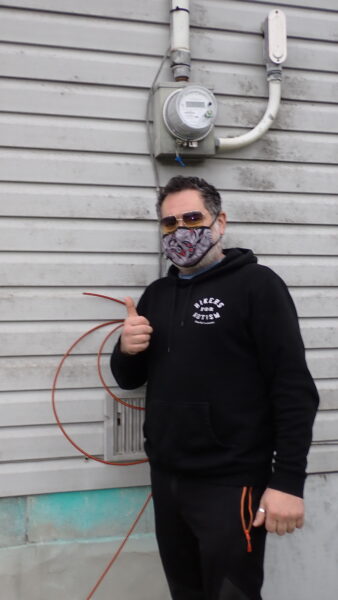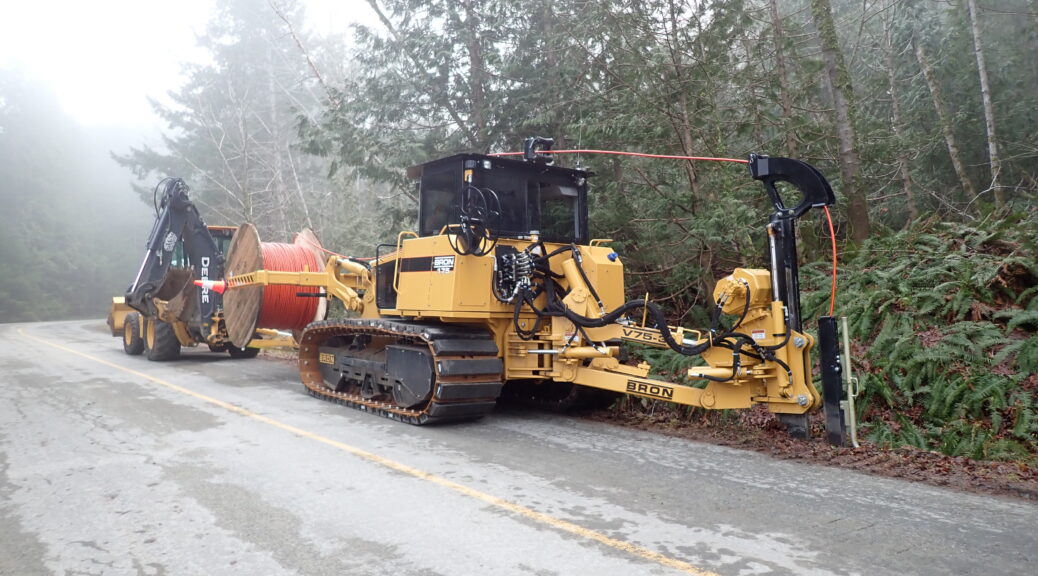Cortes residents on their travels about the island will have noticed some new roadside sights this January. Several sandwich boards bearing the CityWest logo have appeared in scattered locations, as well as road-work crews with some unusual, specialised heavy equipment.
All this activity is part of the initial phase of the Connected Coast project on Cortes Island.
The $4.3 million last-mile project is financed in part by the provincial government and operated by CityWest. […] The Connected Coast will provide backbone communication services to Cortes Island, as well as 138 other rural and remote communities, including 48 Indigenous communities – representing 44 First Nations – along the BC Coast from Prince Rupert, to Haida Gwaii, south to Vancouver, and around Vancouver Island.
—SRD press release Jan 27 2022
Pat Hubbard is the COO of West Connect Infrastructure Corporation (WCI is the logo you’ll see on their vehicles), a wholly-owned subsidiary of CityWest created specifically to tackle the Connected Coast Project. I visited the crews at work on the road near Squirrel Cove on January 26-28, and asked her how the project was going. She said that progress was pretty good–despite early snow delays and supply-chain challenges–and they hope to be done with the heavy-equipment phase “by the end of March.”
The heavy-equipment phase means the burying of the fibre cable bundle safely underground along 76 km of our roadways. Bringing individual fibres out to homes and businesses is a separate phase, involving a different set of skills and (somewhat lighter) specialised equipment; as soon as the main cable is buried, the “heavy crew” will be off to other islands (Quadra, Denman, and Hornby in 2022).
The crew of a dozen or so were chosen for their specific experience with DDR and trenching equipment, and some were recruited from inland provinces, including “the patch” in Alberta. The crew members I interviewed were not familiar with this part of the province and found Cortes Island very beautiful, even in the recent heavy fog. Unfortunately they work long hours on a continuous 3 week shift (with one week off per month) so have little time to explore.
WCI’s crews will be with us for at least another two months. While I was interviewing them, several islanders drove by at speeds too high for worker safety. Pat and her crew asked me to remind Cortes residents to please slow right down when passing through the flagged work zones.
When the “last mile” is complete in the many locations served by the project, undersea cable will be laid to landings where it gets spliced to each community’s local fibre network. On Cortes, there will be cable landings at Smelt Bay, Squirrel Cove, and Whaletown Bay. There’s no firm schedule yet for completion of undersea cable, but Dino Tsakonas (now with CityWest) told me if all goes well it should be soon after completion of the last-mile phase: “April-ish.”
If there are no snags, it’s possible that the southern region (that includes us) might light up sometime this summer.
When the entire Connected Coast project is complete, Cortes residents will have a direct fibre connection to the Vancouver Internet Exchange, and CityWest will have a grand fibre loop: from Prince Rupert to Vancouver via the mainland and back up from Vancouver to Prince Rupert via the coast. This redundancy should ensure continuous service even if one leg goes down.
CityWest’s service offerings are visible on their web site. Cortes residents who would like to use these services when the fibre lights up, are advised to sign up now (there’s a “Sign Up” button on the web page). Signing up in advance not only guarantees up to 100 metres of free fibre run onto your property, but two free months of internet service. Those residents who have separate rental units on their property can request dedicated fibres to provide cabins or tinyhomes with independent internet service.
CityWest’s offerings and rate structure are a bit different from what we have been accustomed to. According to Dino, there will be no total throughput limit (GB per month); rate plans will be based on connection speed (performance), not amount of data transferred. Additional services can be piggybacked on the fibre, including voice (landline) and cable TV. Dino expressed a strong intention on the part of CityWest to keep their network live in the event of power outages.
The Connected Coast is a tremendously ambitious project, a far-sighted investment in long-term infrastructure. This Spring, Cortes residents can see it becoming real on (and under) the ground. Cortes Currents will continue to provide updates, especially when new and interesting equipment arrives on the island or a project milestone is reached.
[I’m a sucker for both cable-pulling and earth-moving equipment, the more specialised the better. If you share my interest in projects of this kind, read on for more technical details and photos. Many thanks to the friendly and cheerful WCI crew — especially Pat, Thomas, and Cody. Thanks also to Dino who showed me a “last few feet” connection in Tork. These folks generously took time out of their busy day to share explanations and technical details; any errors are my own and due to failures of memory or note-taking.]
For those who like to know these things, this is how the conduit burial is done. [All photos by De Clarke, Jan 2022]
First, a conventional digger makes rectangular holes by the roadside in locations previously identified by the surveyors. Some of these holes will eventually contain lightweight composite junction boxes for access to the cable bundle for breakouts and splices. Others are merely convenient points at which to join sections of conduit, and will be filled in later.


These pre-dug holes need to be connected by a trench with the conduit buried in it. To achieve this, next on the scene are two much more specialised teams. One team manages “the Big Plough,” an automated ditcher and conduit layer.
This machine uses vibration to soften the soil so it can drag a plough blade through it. The plough blade includes a duct through which the conduit (the outermost container of a fibre run) is automatically laid into the freshly dug trench. The conduit feeds continuously from a spool mounted on the vehicle. The trench semi-fills itself after the blade has passed on.


The Big Plough, despite its vibrating blade, fights significant resistance (drag) from the soil it’s cutting. When it has to go up a hill as well, the challenge is too much for its horsepower and a front-loader is brought in to give it an assistive tow. That’s why there is an “extra” frontloader in my pictures of it.
Standing near the Big Plough in action is a very noisy experience! The crew wear hearing protectors for a good reason.


The second team comes into play when the Big Plough is not the right tool for the local terrain. If the terrain is too rocky, or the conduit path has to pass beneath the road bed, they deploy an even more specialised and ingenious tool: the Directional Drilling Rig or DDR.


This is a horizontal drill rig mounted on a tracked vehicle base. It is routinely loaded with 180 metres of modular drill shaft sections, but additional sections can be added for a maximum drilling range of 880 metres. Extending the shaft is an automated process; a “cassette” of extensions is mounted on the device, and the operator can attach an extension from inside the cab. (The cassette can be seen on the right side of the vehicle in the photo above.)

The cutting bit for this task is steerable; it can be rotated to any desired attitude and then “sawed” back and forth in place. Its spoon shape will cause the drilled hole to bend towards its hollow face when in this mode. The segmented shaft is flexible enough to follow shallow curves.
Once the direction is correct, the bit can resume rotating freely like a normal cutting tool and will proceed straight forward. The cutting face is lubricated with a slurry of bentonite clay, mixed and delivered by powerful pumps in a dedicated trailer; water comes from a tanker truck — which lasts about two days in normal operation. The DDR convoy consists of these three vehicles: the tanker, then the trailer/truck rig for pumping, then the tracked DDR.


Ahead of the drill, the crew uses a sophisticated ranging/locating device to determine the depth, distance away, and cutting direction of the leading drill segment. The drill bit is “live” with an electrical signal which this tool can detect; its local display shows angle, depth, and range of the cutting bit, and this information is also sent to a display in the DDR cab. A crew member on the ground looks far ahead (at spray painted markings left by the surveyors) to establish the long-range goal and help keep the drilled hole on course.


The DDR enables the crew to cross under roads and driveways without damaging the paving. It’s also capable of drilling (slowly) through rock-infested soil that can defeat the faster Big Plough. Between the two rigs, the crew is making good progress: from 1.5 to 2km per day of the 76 km of roadway they have to cover.
Standing near “the sharp end” of the DDR, you can both hear and feel the bit grinding and popping its way through the ground. Sometimes as it encounters rocks, the entire DDR vehicle jerks and jumps on its base, absorbing the tremendous torque of the shaft drive. Sometimes it’s the terrain that jumps and shudders. Either way, it’s an impressive display of power and specialised tool design.

From a distance, the bright-orange conduit looks a little like garden hose. Its wall is far thicker, however, and its material far tougher. Once it’s all in place, the actual jacketed glass fibre bundle will be fed into it with some assistance from compressed air. Individual long fibres will be broken out aboveground at every location with a service drop, for the terminal runs from junction boxes to buildings (Phase Two).



The end result of Phase Two: a conduit coming up out of the ground to a weatherproof box attached to the outer wall of a building, with a fibre end inside it. Phase Three of the land-based operation is when the ISP (CityWest) completes the connection by installing fibre-to-copper modems and “lighting up” the whole system.

Sign-up for Cortes Currents email-out:
To receive an emailed catalogue of articles on Cortes Currents, send a (blank) email to subscribe to your desired frequency:
- Daily, (articles posted during the last 24 hours) – cortescurrents-daily+subscribe@cortes.groups.io
- Weekly Digest cortescurrents – cortescurrents-weekly+subscribe@cortes.groups.io

